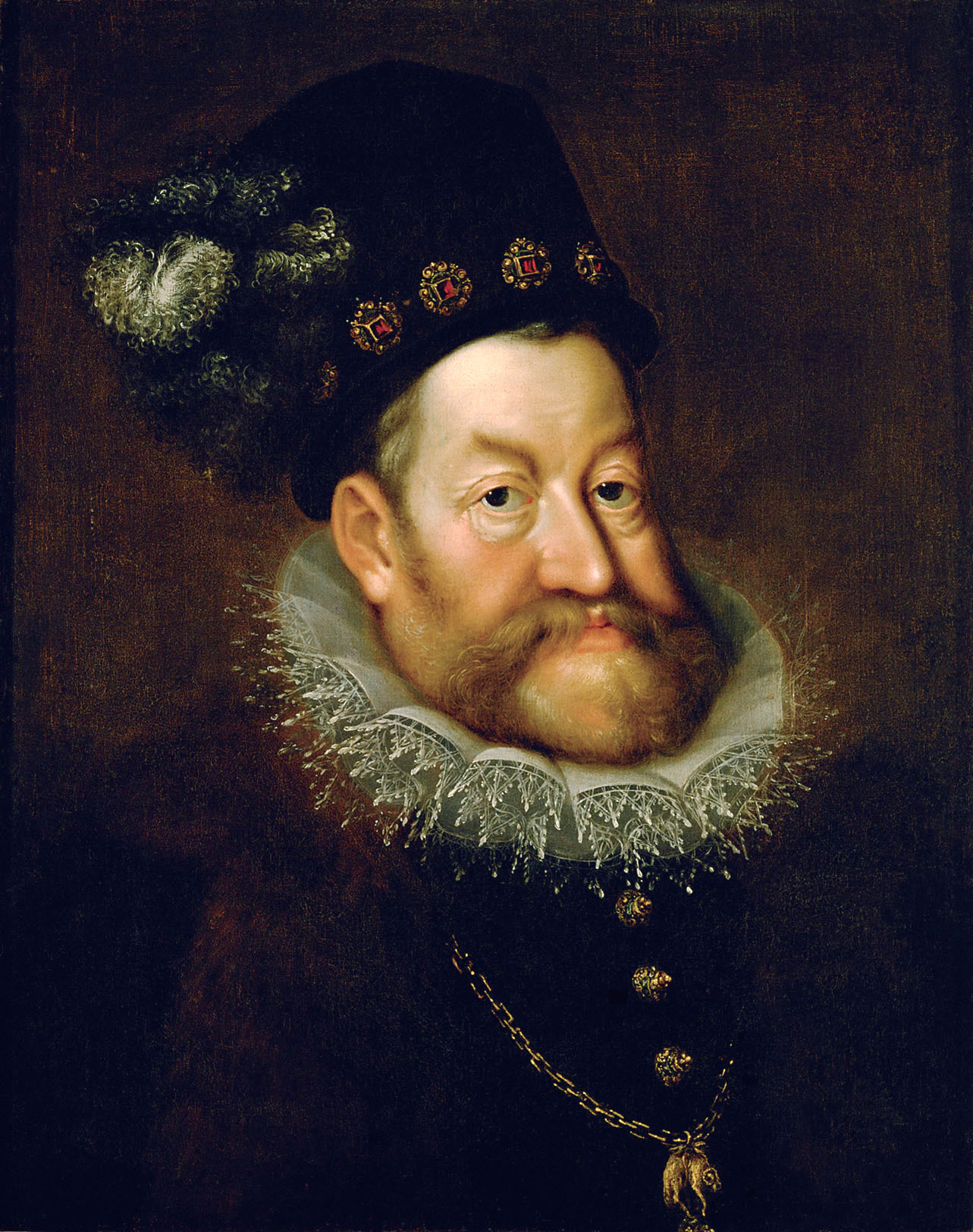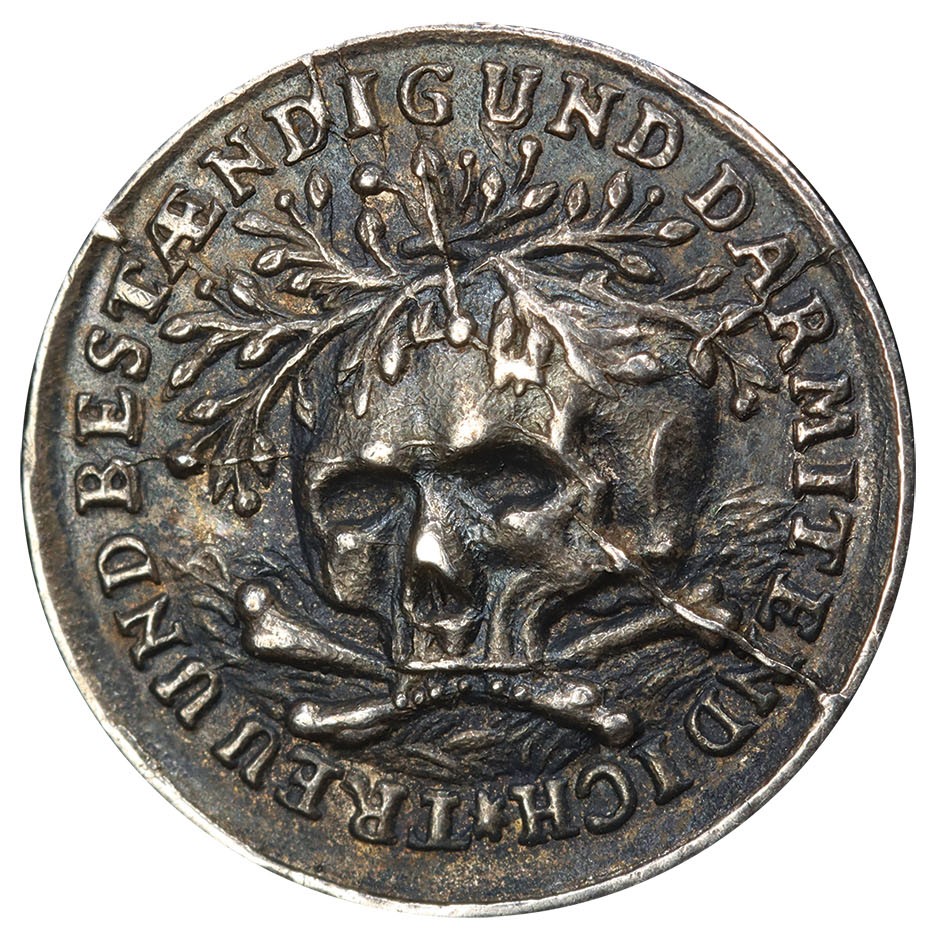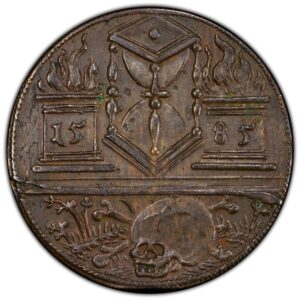
Very Rare 1585 Austrian Raitpfennig “Memento Mori”
Item #CC-0495 | Very Rare 1585 Austrian Raitpfennig “Memento Mori”
Mint: Likely Nuremberg
Date: 1585
Ruler: Rudolf II (1576-1611)
Grade: PCGS AU-55 (Finest and only example graded)
Composition: Copper
For details on this coin from PCGS, click on the serial number here: 48145794
Description: This is a very rare Austrian counting token known as a “Raitpfennig”. This example happens to be the finest and only example graded by PCGS.
This token was made during the reign of Rudolf II (18 July 1552 – 20 January 1612), who was the Holy Roman Emperor between 1576 and 1612. He was also King of Hungary and Croatia (as Rudolf I, 1572–1608), King of Bohemia (1575–1608/1611) and Archduke of Austria (1576–1608). He was also a member of the Hapsburg family and the nephew of King Philip II of Spain.
 Rudolf’s legacy has traditionally been viewed in three ways: an ineffectual ruler whose mistakes led directly to the Thirty Years’ War; a great and influential patron of Northern Mannerist art; and an intellectual devotee of occult arts and learning which helped seed what would be called the Scientific Revolution. Determined to unify Christendom, he initiated the Long Turkish War (1593–1606) with the Ottoman Empire. Exhausted by war, his citizens in Hungary revolted in the Bocskai Uprising, which led to more authority being given to his brother Matthias. Under his reign, there was a policy of toleration towards Judaism.
Rudolf’s legacy has traditionally been viewed in three ways: an ineffectual ruler whose mistakes led directly to the Thirty Years’ War; a great and influential patron of Northern Mannerist art; and an intellectual devotee of occult arts and learning which helped seed what would be called the Scientific Revolution. Determined to unify Christendom, he initiated the Long Turkish War (1593–1606) with the Ottoman Empire. Exhausted by war, his citizens in Hungary revolted in the Bocskai Uprising, which led to more authority being given to his brother Matthias. Under his reign, there was a policy of toleration towards Judaism.
On the obverse of the token is an hourglass flanked by lighted altars containing the date. At the bottom is a skull-and-crossbones set in weeds. On the reverse you see Latin abbreviated text in six lines that says DER · MENSCH/IN · PARADIS: GOTTES · GE/BOT · VORLIS: DRVM · IS · DER · TOT · GEWIS: set within an ornate frame. The Latin text translated into English reads ““Man in paradise left God‘s commandment and therefore death is certain“
Raitpfennigs (or Rechenpfennigs) were a type of counter token used primarily in Central Europe from the 13th to 17th centuries. The term “Raitpfennig”, which essentially means reckoning or accounting penny, was common in southern Germany, while “Rechenpfennig” was more widely used elsewhere. These tokens were not used as currency but calculating aids, functioning like a flat version of the abacus. Merchants and clerks placed these tokens on a board or cloth marked with lines to represent units, tens, hundreds, etc. The value of each token depended on its placement on the board or cloth, not its material or inscription.
What is the Significance of Memento Mori
 In early Christianity, the expression “memento mori” developed with the growth of Christianity, which emphasized divine judgement, heaven, hell, and the salvation of the soul in the afterlife. Memento mori is a Latin phrase, which literally means “Remember death” or “Remember that you die“. The 2nd-century Christian writer Tertullian claimed in his Apologeticus, that during a triumphal procession, a victorious general had someone standing behind him, holding a crown over his head and whispering: “Respice post te. Hominem te esse memento. Memento mori.” Which means “Look after yourself. Remember you’re a man. Remember you will die.”
In early Christianity, the expression “memento mori” developed with the growth of Christianity, which emphasized divine judgement, heaven, hell, and the salvation of the soul in the afterlife. Memento mori is a Latin phrase, which literally means “Remember death” or “Remember that you die“. The 2nd-century Christian writer Tertullian claimed in his Apologeticus, that during a triumphal procession, a victorious general had someone standing behind him, holding a crown over his head and whispering: “Respice post te. Hominem te esse memento. Memento mori.” Which means “Look after yourself. Remember you’re a man. Remember you will die.”
To the Christian, the prospect of death serves to emphasize the emptiness and fleetingness of earthly pleasures, luxuries, and achievements, and thus also as an invitation to focus one’s thoughts on the prospect of the afterlife. This finds ritual expression in the rites of Ash Wednesday, when ashes are placed upon the worshipers’ foreheads with the words, “Remember man that you are dust and unto dust, you shall return.”
Memento mori is an artistic or symbolic metaphor that serves as a reminder of the inevitability of death and the eternal nature of the human spirit. The most common motif is a skull accompanied by one or more bones. The ‘skull and cross bones’ can be seen on some Roman and early Christian tombs, the Knights Templar used it around the 13th century and pirates used it during the Golden Age of Piracy on their flags known as the “Jolly Roger”.
For more information on the history of memento mori style tokens, see our article titled “An In-Depth Look Into Saint Lambert Communion Tokens at https://commodorecoins.com/2023/11/an-in-depth-look-into-saint-lamberts-communion-tokens/
For information on Rudolf II, visit: https://en.wikipedia.org/wiki/Rudolf_II,_Holy_Roman_Emperor

